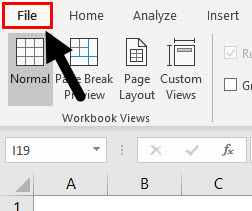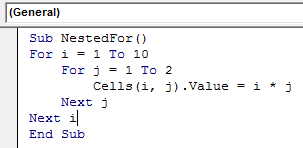

StrStart = rRange 'parse cell content to a String If rCells Is Nothing Then 'Cancelled or mistake Title:="CONCATENATION OF CELLS", Type:=8) & "use Ctrl for non-contiguous cells.", _
#EXCEL VBA ON STEP BACK IN LOOP RANGE CODE#
This code will display an InputBox that allows the user to select specific cells that will all be joined (Concatenated) in the first cell selected. Unprotect with Protect Sub ProtectAllSheets() Loop through all sheets in a Workbook and Unprotect them. On Error GoTo 0 'One sheet will always be left visible On Error Resume Next 'If code tries to hide all Sheets 'You must leave at least one Sheet visible Loop through all sheets in a Workbook and toggle the visibility

Loop through all sheets in a Workbook and Show all Sheets. WsSheet.Visible = wsSheet.Name = "Sheet1" 'We must leave at least one Sheet visible Loop through all sheets in a Workbook and hide all but Sheet1. MsgBox "Number " & i + 1 & " '/' is in position " & _ 'Add one to the found position, for next InStr to Start from. IPositions(i) = InStr(iStart, strText, "/") 'Parse the position of the nth "/" Starting from iStart. 'Tell the array how many elements it is to hold. (Application.Substitute(strText, "/", "")) - 1 In an Array is always zero, unless told otherwise. We then take 1 because the first element _ Len("Ihave/four/OfThese/In/Me") from Len("IhavefourOfTheseInMe") _ 'Find out how many "/" are within the string by subtracting _ Each number representing the position of each / Sub GetIt() The examples below here show what loops are good for, in this case it is looping through a text stringĪnd passing back the positions of / within the string to an array. SearchOrder:=xlByRows, SearchDirection:=xlNext, _ Set rNa = Columns(1).Find(What:="Cat", After:=rNa, _ ILoop = WorksheetFunction.CountIf(Columns(1), "Cat") Instances of the "Cat" in Column "A" of the active sheet. The codeĬould be modified to suit almost any situation very easily. Here is another way to speed up a loop that makes use of Excel's COUNTIF function. 'Loop through needed cells only see if negative Set rAcells = Application.Union(rFcells, rCcells) 'Both MsgBox "You Worksheet contains no numbers" If rCcells Is Nothing And rFcells Is Nothing Then 'Determine which type of numeric data (formulas, constants or none) Set rFcells = rAcells.SpecialCells(xlCellTypeFormulas, xlNumbers) Set rCcells = rAcells.SpecialCells(xlCellTypeConstants, xlNumbers) On Error Resume Next 'In case of no formula or constants. Truth be known I would use conditional formatting!īefore it performs the loop though it restricts the range to only numeric cells.ĭim rAcells As Range, rLoopCells As Range Negative value cells to yellow and the background to red for an entire Worksheet. The example below will change the font color of all Should restrict our range to only the cells we need.

Now sometimes a Loop might be the only way or the best way (not too often though). Now that has to at least make you try alternatives for Loops! Now if you have at least 5 minutes to spare, try this code that uses a Loop:Įsc. SearchDirection:=xlNext, MatchCase:=False).Activate MsgBox "You didn't type 'Find Me'", vbOKOnly, ""Ĭells.Find(What:="Find Me", After:=, LookIn:=xlFormulas, _ If WorksheetFunction.CountIf(Cells, "Find Me") = 0 Then Here is another comparison to stress my point!: I can promise you there is nearly always a built in feature that will executeĪt least 100 times quicker than a Loop. Yes and text for a No, then use SpecialCells to do the rest. Instead of a Loop, try inserting a Column and placing a formula in the required range that makes the check on the cells. Once you Start to make use of these you will always think twice before using a Loop of any kind. Step back and give some serious thought to Excels built in functions. Next time you have a VBA task, don't rush in with a Loop. Range("A1:D500").SpecialCells(xlCellTypeBlanks) = "Blank" MsgBox "All cells are empty", vbOKOnly, "" If WorksheetFunction.CountA(Range("A1:D500")) = 0 Then Used range, i.e it assumes the last occupied cell is D500 Sub WrongWay()Įnd SubNow compare the above code to this one: It Loops through a range and places the word "Blank" in each blank cell within a Take the simple example below for instance. A common mistake we all make when first learning VBA is to use Loops when we really shouldn't. To put it bluntly I very often avoid Loops, they are far too


 0 kommentar(er)
0 kommentar(er)
